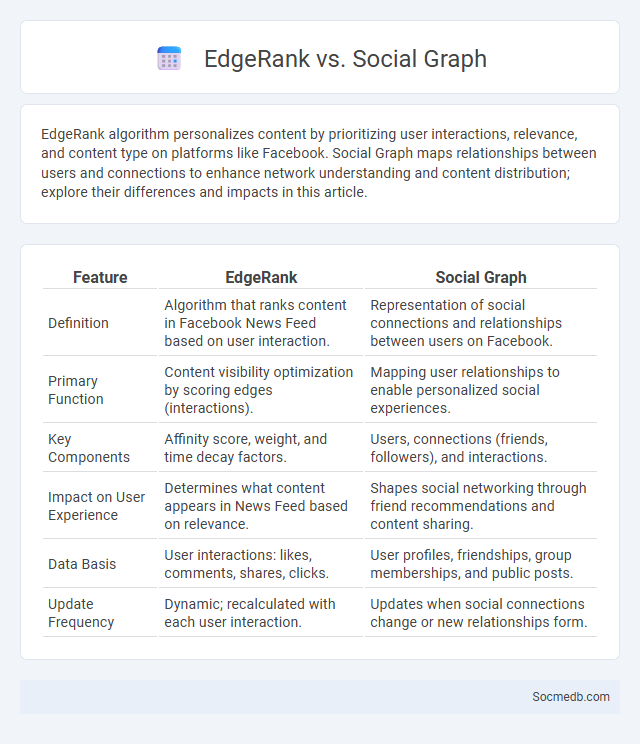
Photo illustration: EdgeRank vs Social Graph
EdgeRank algorithm personalizes content by prioritizing user interactions, relevance, and content type on platforms like Facebook. Social Graph maps relationships between users and connections to enhance network understanding and content distribution; explore their differences and impacts in this article.
Table of Comparison
| Feature | EdgeRank | Social Graph |
|---|---|---|
| Definition | Algorithm that ranks content in Facebook News Feed based on user interaction. | Representation of social connections and relationships between users on Facebook. |
| Primary Function | Content visibility optimization by scoring edges (interactions). | Mapping user relationships to enable personalized social experiences. |
| Key Components | Affinity score, weight, and time decay factors. | Users, connections (friends, followers), and interactions. |
| Impact on User Experience | Determines what content appears in News Feed based on relevance. | Shapes social networking through friend recommendations and content sharing. |
| Data Basis | User interactions: likes, comments, shares, clicks. | User profiles, friendships, group memberships, and public posts. |
| Update Frequency | Dynamic; recalculated with each user interaction. | Updates when social connections change or new relationships form. |
Introduction to EdgeRank and Social Graph
EdgeRank is Facebook's algorithm that determines the visibility of posts in users' News Feeds by evaluating factors such as affinity, weight, and time decay. The Social Graph is a digital representation of the relationships and interactions among users, pages, and content, enabling platforms to personalize and optimize user experiences. Understanding EdgeRank and the Social Graph is crucial for effective social media marketing and content strategy development.
What is EdgeRank?
EdgeRank is the algorithm Facebook uses to determine the visibility of posts in users' news feeds by prioritizing content based on user engagement, affinity, and content type. It calculates a score for each post using factors such as the relationship between the user and the content creator, the interaction history, and the popularity of the post to show the most relevant updates. Understanding EdgeRank helps marketers optimize content strategy to increase reach and engagement on the social media platform.
What is the Social Graph?
The Social Graph represents the network of relationships and interactions between individuals on social media platforms, mapping connections based on friendships, followers, and shared interests. It enables platforms to analyze user behavior, enhance content recommendations, and facilitate personalized experiences. Understanding your Social Graph helps improve how you engage with your online community and where your influence extends.
Core Differences: EdgeRank vs Social Graph
EdgeRank and Social Graph represent distinct approaches to social media algorithms, with EdgeRank focusing on ranking content based on user interactions, affinity, and content weight within the Facebook platform. The Social Graph emphasizes the relationships and connections between users, mapping interactions to personalize content across networks like LinkedIn and Twitter. Understanding these core differences helps You optimize engagement by leveraging both user behavior metrics and network relationships effectively.
How EdgeRank Impacts Facebook Feed
EdgeRank is Facebook's algorithm that determines which posts appear in Your News Feed based on relevance, engagement, and recency. It evaluates factors like affinity between users, content type, and how often people interact with a post to prioritize what You see. Understanding EdgeRank helps optimize social media strategies by boosting visibility and engagement on Facebook.
Role of the Social Graph in Content Discovery
The social graph maps relationships and interactions between users, enabling personalized content discovery by analyzing connections and preferences. Platforms leverage this network to recommend relevant posts, enhancing your engagement and user experience. Understanding the social graph's role helps optimize content strategy for targeted visibility and influence.
EdgeRank’s Algorithm: Key Components
EdgeRank's algorithm prioritizes content based on three key components: affinity, weight, and time decay. Affinity measures the relationship between you and the content creator, weight evaluates the type of interaction such as likes or comments, and time decay favors recent posts over older ones. Understanding these factors helps optimize your social media strategy for increased visibility and engagement.
Evolution: From EdgeRank to Modern Facebook Algorithms
Facebook's algorithm evolved from the original EdgeRank, which prioritized content based on affinity, weight, and time decay, to sophisticated AI-driven systems incorporating machine learning and user behavior analysis. Modern Facebook algorithms emphasize personalized content delivery, leveraging vast signals such as engagement patterns, video consumption, and ad preferences to optimize user experience. This evolution reflects a shift towards predictive analytics and real-time adaptation to maximize relevance and maintain user retention on the platform.
Practical Implications for Marketers
Social media platforms offer marketers unparalleled opportunities for targeted advertising, leveraging data analytics to reach specific demographics with precision. Engaging content and influencer partnerships drive brand awareness, fostering customer loyalty and increasing conversion rates. Real-time feedback and performance metrics enable continuous optimization of marketing strategies, enhancing return on investment.
Future Trends in Social Platform Algorithms
Social platform algorithms are increasingly leveraging artificial intelligence and machine learning to deliver hyper-personalized content tailored to individual user preferences and behaviors. Your engagement patterns will play a crucial role as platforms implement real-time sentiment analysis and predictive analytics to enhance content relevance. Emerging trends also include algorithmic transparency and ethical AI guidelines aiming to reduce bias and improve user trust.
 socmedb.com
socmedb.com